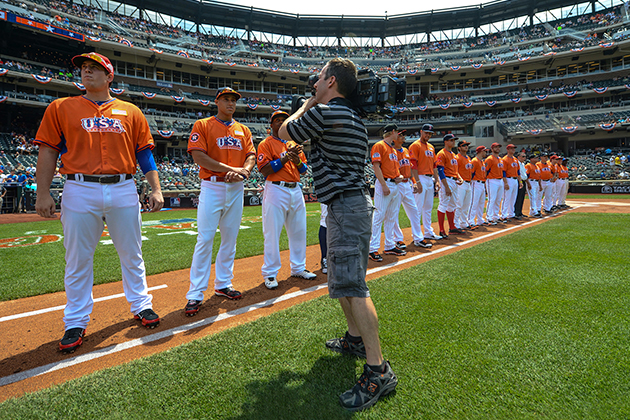
Brian Schulz ’97 (CLAS) is always ready to roll – whether it’s for a professional ballgame or a tournament of teenage chess champions. A producer and cinematographer for Major League Baseball, Schulz also recently served as a producer and the director of photography for the 2012 documentary “Brooklyn Castle,” which tells the story of America’s top junior-high chess team. He lives in New York City.
1. How did you get into sports photography?
It all started at UConn, because I worked in the sports information department [SID]. I did some work on the ESPN production trucks as a student assistant with the SID’s office, and it seemed like a cool career. … I found my creative side – I never really thought I was creative. I can’t draw, I can’t sing, I can’t act, but I had some kind of creativity that took some time to blossom.
2. Had you always been interested in photography?
As a little kid, I liked tuning into the World Series or the Super Bowl to see the video teasers for the game. They would play some cool music, and there would be all these majestic shots. As a kid, I probably didn’t know what I was experiencing, but that probably contributed to my future career choice.
3. You’ve worked at MLB since 1999. What kind of work have you done there?
I [recently] worked on a cinematic essay as a promo for the All-Star Game. One of our writers at MLB Productions wrote a really heartfelt love letter to New York City, voiced by John Franco, a former New York Met and lifelong New Yorker. [We’ve] encapsulate[ed] the beauty of New York and the beauty of the All-Star Game coming to New York. I like really cool, crisp, clean cinematic shots and weaving them into a story.
4. How much traveling does the job involve?
I worked on a Showtime series called “The Franchise” that followed a single team – two years ago, it was San Francisco [Giants], and last year it was the [Miami] Marlins. And other things come up – we do interviews with players throughout the season, so we go to their ballparks and do specialty shots with them. Then there’s the World Series and the All-Star Game every year and spring training.
5. Do you ever get tired of watching baseball?
I’m not as big a fan as I used to be. I think it’s just a natural tendency – if I worked at Baskin Robbins, I’d be sick of ice cream by now. It’s not that I’m sick of baseball; it’s just there every day. Being around it so much, you forget how endearing it can be.
6. What’s one of the most memorable moments you’ve captured?
The 2004 Red Sox victory in the World Series. … I was shooting camera on the third-base side when the Red Sox won, so I captured that last out. When I look back in 30 or 40 years, I’ll know that that slow-motion shot was mine.
7. How did you get involved in “Brooklyn Castle”?
It was actually my sister’s idea – she has always worked in documentaries and wanted to do one of her own. She had this idea of following around the best junior-high chess team in America, which no one really knew about. It’s a really interesting story. They come from a section of Brooklyn where you just wouldn’t think chess would thrive.
8. Was it a challenge to make chess interesting cinematically?
We did a lot of slow-motion and artistic shots, and we weaved it into a story line about what was going on in the players’ lives. We tried to make the chess really interesting. We were at a tournament in Dallas in one of these big, big conference rooms. I like really smooth shots, but we didn’t have the funding for a dolly or a Steadicam. I see a luggage cart that a bellhop is bringing in, and I get on it with my tripod and have my brother-in-law push it. So here I am on this luggage cart being pushed across the room, in the midst of the ultimate concentration sport. It was a poor man’s dolly.
9. You grew up in Brooklyn yourself – is that what drew you to the film?
My sister always wanted to do a film about where we were from, and I gravitated to that as well. I thought it would be good to make a film about something that was emblematic of Brooklyn. I think the best thing about documentaries is that you’re shining a light on a subject that a lot of people may not know about. We try to show that chess is cool – these are some of the most popular kids at their school.

10. What are you working on right now, outside of MLB?
I’m working on some stuff for Fashion Week. It’s fascinating, the process that goes into the fashion shows. I see the parallels to the sports world – there’s a lot of pressure. If you’re a designer, there’s a lot of pressure to have a good show. Then you get the whole dynamic with the models, who are kind of like the athletes. And the shows themselves are like big games now, with all the celebrities and everything.
Follow Brian Schulz on Twitter at @brianJschulz
This article was first published in the Fall 2013 edition of UConn Magazine. To read more stories like these, download UConn Magazine‘s free interactive app for tablet devices.


